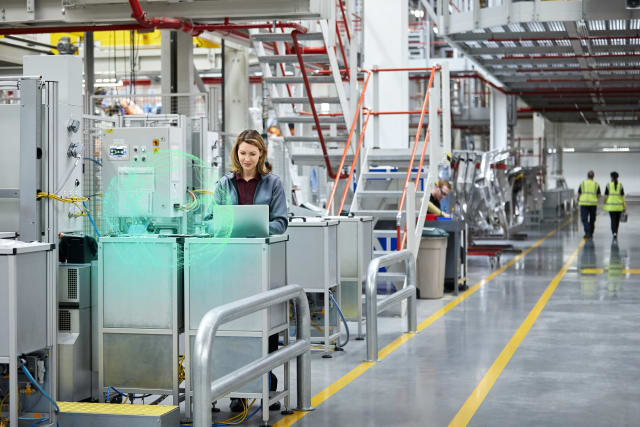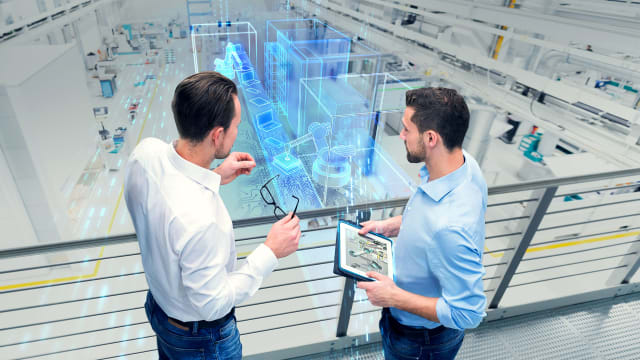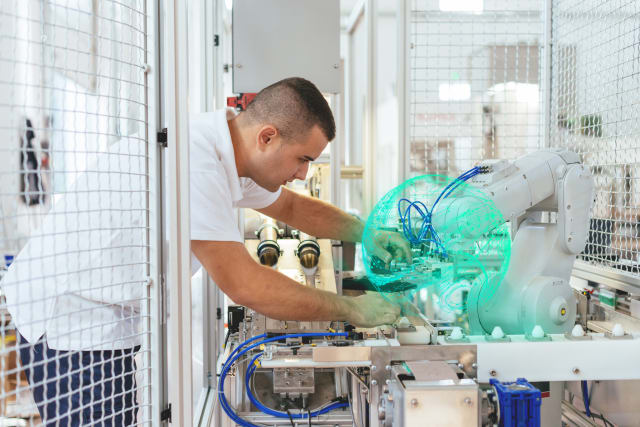How Digital Transformations and PLM Help Engineers Reach Their 2022 Goals
PLM and digital transformations help engineers to improve systems’ sustainability.

Dale Tutt, Vice President of Industry Strategy for Siemens Digital Industries Software
I recently spoke to Dale Tutt, Vice President of Industry Strategy for Siemens Digital Industries Software, about looking forward to 2022. By the end of that conversation, one thing was clear: it is hard to predict uncertainty, but PLM and digital transformation can go a long way to help mitigate the risks.
For instance, take the supply chain disruptions caused by COVID-19, the Suez Canal and other issues in recent memory. It’s safe to say much of that will bleed into 2022. To that, Tutt said, “There were a lot of cracks in the supply chain before COVID. Companies were throwing people at it. COVID accelerated some of those events, and it has accelerated transformations. Those that were farther along in their digital journey, that had set up that supply chain, they actually adapted a lot faster.”
He added that this caused a boom in the demand for digitization. As corporations noticed which companies were weathering the storm better, and how they were doing it, demand grew. “A lot of companies are seeing the time and cost benefits of digitization. But I think that they are also seeing the risk mitigation because they have better information and data, and they are actually doing things with the data. As they start to apply more data analytics, they’re going to develop a much stronger understanding of their company supply chain, manufacturing processes and challenges.”
But a shortage of supplies is not the only challenge of 2021 that will continue in 2022; there is also the shortage of people and what is being called the “Great Resignation.” Can digital transformations and PLM help on that front?
“I do think we will continue to see the trend that companies can’t find people to fill the jobs. It doesn’t matter what the job is, it could be flipping burgers, building cars or building planes. I think that is going to continue to be a problem,” Tutt said.
“But,” he added, “What may only be seen by some is that it’s not so much a shortage of people, but a shortage of skill sets. You’re seeing this growth in the complexity of products and the amount of software that is going into the products. So, you’re always in this place where you have to add people, especially with certain skill sets like software or electrical engineers—you name it—when you’re talking about product development. The ones that are really going to solve the problem are the ones that are figuring out how to retool the business, address their skill set needs through better technology.”
In other words, much like the supply chain issues, the people and skills gaps will likely remain a challenge long after COVID-19 is tucked away in the history books. Those that adapt through technology are the most likely to succeed.
The Challenges of 2022 Will Put an Emphasis on Sustainability
Based on these supply chain, skills and people shortages, what will the goals of companies be in 2022? There is no way to be sure, but for any organization that is paying attention to these challenges and the way the wind is blowing, their goal should be to focus on sustainability.

Companies are learning that you can make green by being green. (Image courtesy of Siemens Digital Industries Software.)
In some corporate circles, going green has gotten a bad reputation. Personally, since my Masters, I’ve been trying to convince companies that going green can make green. Now, with tools such as PLM, it seems some organizations are starting to catch on to the financial benefits of sustainability.
When I speak of sustainability, I’m not just talking about the planet—though that is a big part of it. It’s also about ensuring the resilience of a system. For instance, take the start of the pandemic. Tutt explained, “as companies saw their businesses had to shut down for a period of time—like the airline industry—the natural reaction was to lay people off. ‘I have to get rid of 30 percent of my people because I have reduced income.’ It felt like there was this expectation of, ‘When we decide it's time for them to come back, they're going to be beating down our door to come back.’ They’re not coming back.”
Laying off a slew of well trained, hard-working people when things get bad may be a corporate trope, but is it truly sustainable? Those people need to eat, they need healthcare, they have families to support. They won’t sit around waiting for a factory to open again.
Tutt had a great metaphor which also brings in how this situation parallels the current supply chain challenges. “It’s kind of like the chip shortage that’s affecting so many different companies right now. They said, ‘Hey chip manufacturers, I’ve slowed down production, I don’t need my chips so stop my contracts for now.’ Then with everyone staying home, they need tech, they need cameras, new phones, they’re buying stuff. So now the chip manufacturers are like, ‘I can make stuff for them.’ The chip factories didn’t go away, they’re making so much money now and saying, ‘Why do I want to go back to those other guys that weren’t paying me enough money and beating me down on prices?’ That’s the dynamics, businesses moved on. So has the economy, and the people have moved on to other things too.”
When it comes to those companies that laid off those people, or stopped those chip contracts, Tutt joked they must be asking, “How come nobody is returning my call? How come they don’t love me anymore? I don’t get it.” The chips are going to other, more loyal, customers. And those employees took their training and went somewhere else, or they have entered a new industry, while some lucky one has been able to retire.
As for the co-workers that evaded the lay-off, they’ve learned from it and the success of their friends as they have moved around the economy. In other words, the Great Resignation can be traced back to that initial lay-off.
Where is the sustainability in these examples? Training a whole new workforce, as well as finding and breaking in a new supplier—plus the shutdown these may cause, once your product is back in demand—can be much more costly than any money saved from a massive layoff.
Tutt stresses that the job pool crisis won’t be getting any easier. “It’s worse than it used to be because the market dynamics and job dynamics are changing faster than we train people and how we teach them these things in universities. Then on the other end, you have people taking an early retirement.”
As for how being sustainable can help both a company and the environment? The supply shortage can answer that one too. When Tutt used to work in the Aerospace industry, he mentions how the norm was to start with a 200-pound piece of aluminum and machine it down to a 20-pound part. “We created 180 pounds of chips!” he said. Now, if the pricing of aluminum goes through the roof—for example, because a pandemic has shut down smelters and recyclers—it might make a company think about a more sustainable manufacturing process such as additive manufacturing.
“I think we’re going to see a lot of focus on sustainability. It was seeing some momentum, and you see a lot of investments in areas where there is more interest in seeing sustainability,” said Tutt. “Programmatically, a lot of companies are looking into how to manage their risk, costs and getting new products to market faster. Then when you think about sustainability and you tie these all together, it’s not just about building products more sustainably; it’s also about building them more profitably and faster.”
PLM and Digital Transformations Optimizes Sustainability
So, how can PLM and digital transformation help to improve a system’s sustainability? The answer lies in the digital twin, simulation, analytics and a better understanding of every company process.

“You can’t have business transformation without digital transformation,” said Tutt. (Image courtesy of Siemens Digital Industries Software.)
“If you want to talk about reducing the carbon impact of your whole manufacturing process it isn’t just about your factory,” Tutt explained. “It’s also about the 17 other factories that are supplying things. So, it’s about looking at your entire process and what are those impacts. The companies that are the most connected and have the understanding of their whole business process will have the best ability to address those questions.”
He added, “Companies that are being sustainable are actually being very profitable, there are a lot of benefits. It doesn’t have to cost you money to become sustainable. The companies that can unlock that the fastest are going to get the most benefit from the business outcomes. It’s going to be fun to watch and we’re happy to be working with them on that.”
Tutt gave an example from his past that really drives this concept home. He used to work at a facility that would manufacture metal parts and he noticed that they would always polish them to a sheen. He wondered why, as it didn’t serve any practical purpose to the product these parts would be a part of. The reason was that the facility primarily relied on natural light. By shining the parts, which cost little and produced little waste, the parts could be properly inspected for defects without the need to spend massive amounts of money on electrical lighting.
“They made a slight change to their process in order to take advantage of a monetary and sustainability savings,” said Tutt. “I think across the board when you start to look at your business processes, coupled with the technology that is being used to design and build your products, that’s when you can really start to take the money out of your processes. It’s a bit of investment that pays you back every week. That’s where you make green.”
“The companies that are beginning to excel have fully embraced digital transformation. They’re taming the complexity of their business processes at the development of their products. You can’t have business transformation without digital transformation,” he added.
How PLM and Digital Transformations Help Supply Chain
This added visibility into the sustainability of the system can also be applied to helping support the supply chain.
“A lot of the time when we talk about the digital twin, people tend to think about products and manufacturing processes,” Tutt explained. “They tend to think of it in terms of physical objects. But think about the digital twin of your business processes. That is really what the supply chain is all about. Once you have that digital twin you know your entire supply chain. You know where parts are coming from, the risks involved and where you can focus to improve cycle time.”
As an example, Tutt explained it this way: if a digital twin only includes a production facility, it might be able to help you optimize your system so that the facility can ramp up from 20 to 40 parts a day. However, if your suppliers are only able to send you 30 parts a day, you’re not going to reach that new throughput. By applying the digital twin to the supply chain, you have this visibility, and you can look to new options that will support that larger throughput.
An extension of this logic also plays into the opening of a facility. When a new factory starts production for the first time, it is often hard to predict what may happen ahead of time. However, by producing a digital twin of that plant before a shovel even breaks ground, engineers can go through a virtual commissioning of the system and discover issues before they encounter them in real life. “That’s where you’re going to start to see a lot of benefits,” Tutt said.
But a similar digital twin of an existing production facility could also help to future-proof it against any disruptions that could come its way. “There is more of an emphasis on what’s going on in my supply chain,” Tutt said. ”Such as, where am I going to build these parts and how will a disruption from a plant—five suppliers up the chain and 10,000 miles away—for three weeks due to an illness, disrupt my product? The visibility, communication and transparency up and down the supply chain is probably going to be a really big area of focus that is now on the radar of companies.”
Digital Transformation Fills in Skill Gaps and Maintains Workforces
A better understanding and a digital transformation of the entire company and its processes will also go a long way toward filling in the skills gaps within your workforce, and helping to maintain the high-quality, trained employees currently on the payroll.

With proper collaboration and digital support, employees focus on KPI rather than sending data around. (Image courtesy of Siemens Digital Industries Software.)
“The benefit of digital transformation isn’t just about bringing technology to bear, it’s also about changing your processes as well as teaching and training your people,” Tutt says. “So, when you start to address some of these issues and gaps you want to do it with productivity and better tools. You have to look at it from a holistic standpoint—the people, tools and processes. The connectivity of the PLM backbone, that really sets up the digital thread and data sharing. It’s making it a lot easier for companies to go more digital and it’s making the collaboration much better.”
With that collaboration and digital support, employees are focusing more on KPI than they are sending data around. This both opens them up to new ways to work, which fits well with the trends towards working from home.
“Task automation really helps to unlock innovation because your people are focusing on solving the problems they need to solve, instead of figuring out how to get data from point A to point B,” confirmed Tutt. “The foundation of that is a strong PLM backbone that is giving you a digital thread, configuration management, data orchestration and parameter management.”
He added, “I think if you would have talked to me as a chief engineer, three or four years before the pandemic, when I was still leading big engineering teams, we had people that wanted to work remotely more often. We were kind of like, ‘Well it’s hard to do’ and so we were always reluctant to do it. Then all of a sudden, at the start of the pandemic, you didn’t have a choice. Companies adapted, they changed their work processes with people, they got the technology. The camera I have is something I didn’t have until COVID started.”
Tutt then explained how thanks to that camera, people he’s worked with for years that he would normally only talk to on the phone have been properly introduced to him. “People are having to adapt. How do you be inclusive when you have a Zoom meeting with little frames of people? How do you engage with people so they’re not snoozing? People are adapting.”
“People have also changed their habit of going out to visit a supplier,” he added. “They would go and send an inspector to inspect parts and do source inspections. Now they are saying it is not feasible to send people on-site anymore. They now use facetime calls with people walking around a plant with iPads showing people the factory setup. They are doing business in a different way. The tools have allowed them to be more flexible. You’re no longer going to fly out to California to see a supplier for an hour and a half and wonder, what am I going to do with the rest of my time here?”
But now for the big question: What will happen when COVID is entered into the history books? Has the business world shifted forever? Or will the pendulum swing back?
To that, Tutt said, “The benefits that companies are seeing from the digital thread and digital transformations, they are now saying, ‘Okay, what else can I get?’ I think they are getting the collaboration and connectivity they need and they’re starting to get more things done electronically. I just don’t think that from a company perspective they will ever want to go back to that world. There’s a time and place for events and big company meetings where you bring people in. You don’t just have the meeting; you have the networking and socialization that happens.”
But Tutt argues that the productivity isn’t always there. In the past, you might schedule a two-day meeting because that’s what made sense to justify getting everyone to travel to a company-wide meeting. But now you can have a four-hour meeting, covering the topics you specifically wanted to cover. You no longer have to fill in the time, and add in more topics and discussions, just to justify those two days.
This logic can then be expanded further. Why spend money on office space when everyone with a desk job can work from home? If the digital twin makes this possible, why not take financial advantage of it? Not every job can be done from home, but if 60 percent can, then isn’t that a significant savings in office overhead costs and carbon footprint?
At the end of the day, digital transformation just makes it more sustainable to work from where you are, how you want to work and when you want to work. If that isn’t a win for both employees, employers and the planet, then I don’t know what is.








